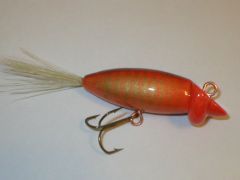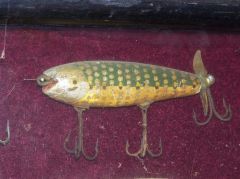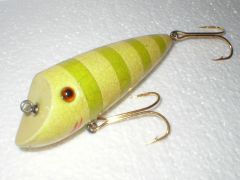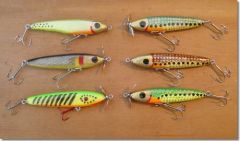-
Posts
167 -
Joined
-
Last visited
Content Type
Profiles
Articles
TU Classifieds
Glossary
Website Links
Forums
Gallery
Store
Everything posted by Mallard
-
The size of the wheel is really unimportant, it only dictates the speed the lure moves through space, which is not a factor unless the lure is moving so fast the the friction of the air pushes the topcoat around or centrifugal force exceeds gravity. So, a bigger wheel can only hurt the process. What really matters is the RPM. RPM/2 tells you how often the lures rotates 180 degrees (flips over) each minute. 4 to 6 RPM seems to work just fine.
-
It would also be a good idea to sign the bait to avoid any confusion in the future.
-
How do you apply it? Spray on, brush on, dip or soak?
-
KcDano, Yes it is an early Jim Pfeffer, believed to be his first bait, carved in the mid to late 1920s. It is also believed to be the origin of his famous "Orlando Shiner" paint scheme. However, it is not a bluegill, but a sunfish. Close enough, I'll give it to you. JSC, Good eye! The Nip-I-Diddee 910 SH was definitely an attempt to create a mass-market version of the Pfeffer Orlando Shiner. However, South Bend was not the first to "borrow" the shiner paint scheme. Several Orlando area makers primary lure was the Orlando Shiner, which was a variation of Pfeffer's. The South Bend adaptation was used on the the Diddee family along with the Bass Oreno. This paint scheme became known as the Spotted Ape and was used by several major makers, including: Heddon (Lucky 13) Arbogast (Jitterbug) Smithwick Boone York/Rhoden and some guy named Mallard You're up KcDano
-
-
Thanks for the info, that is the company I saw on this site.
-
Does anyone have any experience with this product? I remember a product was advertised on this site a while back. Did anyone purchase from them and have their contact information? I am looking for the epoxy, the curing light and information on setting up the work area (lighting, ventilation, etc) Thanks!
-
I heard Bagley went to CNC when the moved production to Hondrus. The baits are prototyped in the US and cut out on a small CNC machine then tested. The production machines are large fast machines that cut the baits as two separate halves which are glued together later. This requires cutting in only three axis.
-
A central Florida get together sounds great. I am in Apopka, just north of Orlando. I am definitely willing to help out. Rob Mallard
-
I was at that show too, Jerry! I should of figured you would be attending. I got some interesting info from the Techno CNC folks about how some large lure makers are using their equipment. Hope to post that info soon. Rob
-
-
Hey Daymon, I never used the type of lure you are working on, but I did buy a couple Cheek Chub Open Mouth Shiners to test fish. They come from the same time period as the Shur-Strike. The OMS is unweighted and I thought they might work like the Darter that eventually replaced them. I was a bit surprised to discover they had no real action at all. In fact they sat so high in the water that it was little more than a glider. I think a stick with a hook attached would have better action. That fact is a lot of early baits (pre 1930) were junk compared with modern baits. Maybe the original Shur-Strike wasn't much better than your replica. I made my our OMS replicas, but I chin weighed them to get the lip (forehead) to bite enough to force a shallow dive and swim action. They turned out to be super baits. I would suggest a weight just forward of the collar to get the lip to bite. You may also need a bit of weight mid-body or 3/4 back to keep the tail wiggle under control. The brissles in the tail of the orange bait probably help control the action in that bait. I really like that orange bait a lot by the way. Rob
-
I would love to find an affordable and ready supply of white cedar also. And this is just my personal opinion, but I think bass word is good for carving but it does not compare with AYC when it comes to durability. It is heavier though.
-
I am not familiar with Alpamate, but I use Alaskan Yellow Cedar for some saltwater prop baits. They stand up well to snook, trout, lady fish and the occasional small tarpon. I've sold a few to guys using them for Pea####s in south FL and never had a problem. Most are wire-thru, but AYC does hold screw eyes well. The bait in my avatar is made from AYC.
-
You are right Doomdart. I "assumed" BigRedFish was talking about top coats since he mentioned the spray-on product. I too expect my "sealer" to penetrate the wood to some degree. I believe the water-based polyeurathane can be used as a wood sealer and will pentrate the wood if soaked, but I don't see it as the best solution. I have been successful sealing WRC with E-tex thinned with an equal part of laquer thinner. I apply a thick coat and let it drip for few minutes then wipe off the access. I get the same sharp ping when dropped as LaPala mentioned. With that being said, I also plan to experiment with the Prop as a wood sealer.
-
-
I used the brush on version and dipped my baits in it. I only used it on some baits I painted as practice and then gave away to some kids so I don't know how well they held up. Epoxies, like Devcon are more durable but the MinWax polyeurathane is quite tough. I liked it because it was easy to use and created a thin coat that I prefer on small baits. I have since switched to E-tex, which I feel better fits my needs. I dipped each bait 5 or 6 times about an hour apart, and hung them to dry. While it dries to the touch in less than a day, it needs up to two weeks to setup properly. I learned this from a flooring company that uses it with great results. I am not sure that the spray-on version can give you the same results. Also, it is water based so clean up is easy.
-
Here's a thread from a couple of years ago. Unfortunitly not are the pictures are still there but I think you can get the idea. http://www.tackleunderground.com/forum/showthread.php?t=5128
-
Another point to remember, what you see posted here is the best of the best, not the hundreds of mess-ups that were thrown out along the way.
-
-

shaping hardwood lures sander or dremel or router
Mallard replied to mark berrisford's topic in Hard Baits
I use a sanding drum mounted in my drill press. It works like a poor man's spindle sander. Nice thing is it allows one tool to do double duty, or if you want a dedicated sander you can get by with a Harbour Frieght cheapy drill press ($40 on sale). It also takes less space than the spindle sanders and it is so easy to chuck up different size drums. -
I find epoxy too hard to sand so I use just enough to hold the weight but not fill the hole. Once the epoxy is dry I use Durham's Rock Hard Water Putty to fill the hole. It is a powder that you can mix to any consistancy you choose. It drys very hard but is quite sandable, especially if you catch it before it has fully set. Also, it does not shrink like some of the other putties I have used. I can not find Durham's at Lowes or Home Depot but the ACE in my area carries it. A can goes a long way so it is a good value too.






